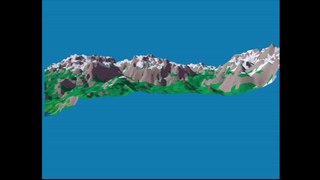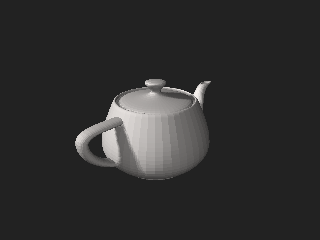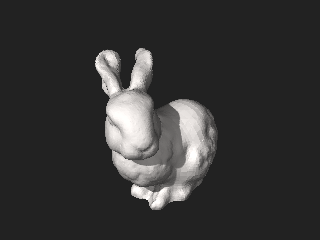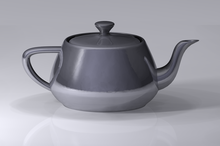
Rendering or image synthesis is the process of generating a photorealistic or non-photorealistic image from a 2D or 3D model by means of a computer program. The resulting image is referred to as the render. Multiple models can be defined in a scene file containing objects in a strictly defined language or data structure. The scene file contains geometry, viewpoint, texture, lighting, and shading information describing the virtual scene. The data contained in the scene file is then passed to a rendering program to be processed and output to a digital image or raster graphics image file. The term "rendering" is analogous to the concept of an artist's impression of a scene. The term "rendering" is also used to describe the process of calculating effects in a video editing program to produce the final video output.

The painter’s algorithm is an algorithm for visible surface determination in 3D computer graphics that works on a polygon-by-polygon basis rather than a pixel-by-pixel, row by row, or area by area basis of other Hidden-Surface Removal algorithms. The painter’s algorithm creates images by sorting the polygons within the image by their depth and placing each polygon in order from the farthest to the closest object.

Scanline rendering is an algorithm for visible surface determination, in 3D computer graphics, that works on a row-by-row basis rather than a polygon-by-polygon or pixel-by-pixel basis. All of the polygons to be rendered are first sorted by the top y coordinate at which they first appear, then each row or scan line of the image is computed using the intersection of a scanline with the polygons on the front of the sorted list, while the sorted list is updated to discard no-longer-visible polygons as the active scan line is advanced down the picture.
Franklin C. (Frank) Crow is a computer scientist who has made important contributions to computer graphics, including some of the first practical spatial anti-aliasing techniques. Crow also proposed the shadow volume technique for generating geometrically accurate shadows.

John Edward Warnock was an American computer scientist, inventor, technology businessman, and philanthropist best known for co-founding Adobe Systems Inc., the graphics and publishing software company, with Charles Geschke in 1982. Warnock was President of Adobe for his first two years and chairman and CEO for his remaining sixteen years at the company. Although he retired as CEO in 2001, he continued to co-chair the Adobe Board of Directors with Geschke until 2017. Warnock pioneered the development of graphics, publishing, web and electronic document technologies that have revolutionized the field of publishing and visual communications.

The Utah teapot, or the Newell teapot, is a 3D test model that has become a standard reference object and an in-joke within the computer graphics community. It is a mathematical model of an ordinary Melitta-brand teapot that appears solid with a nearly rotationally symmetrical body. Using a teapot model is considered the 3D equivalent of a "Hello, World!" program, a way to create an easy 3D scene with a somewhat complex model acting as the basic geometry for a scene with a light setup. Some programming libraries, such as the OpenGL Utility Toolkit, even have functions dedicated to drawing teapots.

In human–computer interaction, WIMP stands for "windows, icons, menus, pointer", denoting a style of interaction using these elements of the user interface. Other expansions are sometimes used, such as substituting "mouse" and "mice" for menus, or "pull-down menu" and "pointing" for pointer.

The Stanford bunny is a computer graphics 3D test model developed by Greg Turk and Marc Levoy in 1994 at Stanford University. The model consists of 69,451 triangles, with the data determined by 3D scanning a ceramic figurine of a rabbit. This figurine and others were scanned to test methods of range scanning physical objects.

Non-photorealistic rendering (NPR) is an area of computer graphics that focuses on enabling a wide variety of expressive styles for digital art, in contrast to traditional computer graphics, which focuses on photorealism. NPR is inspired by other artistic modes such as painting, drawing, technical illustration, and animated cartoons. NPR has appeared in movies and video games in the form of cel-shaded animation as well as in scientific visualization, architectural illustration and experimental animation.

Marc Levoy is a computer graphics researcher and Professor Emeritus of Computer Science and Electrical Engineering at Stanford University, a vice president and Fellow at Adobe Inc., and a Distinguished Engineer at Google. He is noted for pioneering work in volume rendering, light fields, and computational photography.

Patrick M. Hanrahan is an American computer graphics researcher, the Canon USA Professor of Computer Science and Electrical Engineering in the Computer Graphics Laboratory at Stanford University. His research focuses on rendering algorithms, graphics processing units, as well as scientific illustration and visualization. He has received numerous awards, including the 2019 Turing Award.
PDMS as it is known in the 3D CAD industry, is a customizable, multi-user and multi-discipline, engineer controlled design software package for engineering, design and construction projects in offshore and onshore.
Richard G. Newell is a British businessman and technologist in the software industry in Computer aided design (CAD) and Geographic Information Systems (GIS).

Computer graphics is a sub-field of computer science which studies methods for digitally synthesizing and manipulating visual content. Although the term often refers to the study of three-dimensional computer graphics, it also encompasses two-dimensional graphics and image processing.

Computer graphics deals with generating images and art with the aid of computers. Today, computer graphics is a core technology in digital photography, film, video games, digital art, cell phone and computer displays, and many specialized applications. A great deal of specialized hardware and software has been developed, with the displays of most devices being driven by computer graphics hardware. It is a vast and recently developed area of computer science. The phrase was coined in 1960 by computer graphics researchers Verne Hudson and William Fetter of Boeing. It is often abbreviated as CG, or typically in the context of film as computer generated imagery (CGI). The non-artistic aspects of computer graphics are the subject of computer science research.
Maureen C. Stone is an American computer scientist, specializing in color modeling.

William Maxwell Newman was a British computer scientist. With others at the Xerox Palo Alto Research Center in the 1970s Newman demonstrated the advantages of the raster display technology first deployed in the Xerox Alto personal workstation, developing interactive programs for producing illustrations and drawings. With Bob Sproull he co-authored the first major textbook on interactive computer graphics.

The Kahlert School of Computing is a school within the College of Engineering at the University of Utah in Salt Lake City, Utah.

Gooch shading is a non-photorealistic rendering technique for shading objects. It is also known as "cool to warm" shading, and is widely used in technical illustration.















